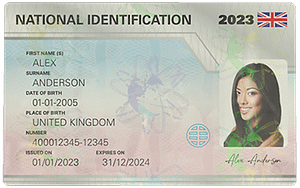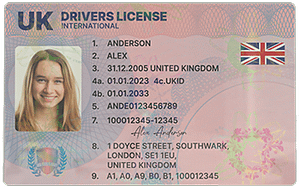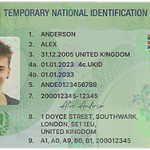Airport security is a crucial aspect of ensuring the safety and security of air travel. One of the key tasks in this process is detecting fake ID cards. Fake ID cards can be used by individuals with malicious intentions, such as terrorists or criminals trying to board flights under false identities. Here are the various ways in which airport security personnel detect these counterfeit documents.
Visual Inspection
The first – line defense in detecting fake ID cards is a thorough visual inspection. Airport security officers are trained to look for a variety of visual cues. They start by examining the overall appearance of the ID card. Genuine ID cards have a certain texture, color quality, and finish. For example, the lamination on a real ID is usually smooth and evenly applied, while on a fake one, it may be uneven, bubbly, or have a different feel to the touch.
The photo on the ID is also closely scrutinized. The quality of the photo on a real ID is high – resolution, with clear details of the individual’s features. Fake photos may appear pixelated, blurry, or have a different color tone compared to the rest of the ID. Additionally, security officers check for any signs of tampering around the photo area, such as uneven edges or glue residue, which could indicate that the photo has been replaced.

The text on the ID is another important element. Real ID cards use specific fonts, sizes, and spacing for the printed information. A fake ID may have incorrect font styles, or the text may be misaligned or of inconsistent size. Moreover, the security features printed on the ID, such as holograms, watermarks, or microprinting, are carefully inspected. Holograms on real IDs have a three – dimensional appearance and change color and pattern when viewed from different angles. Watermarks are usually visible when the ID is held up to the light, and microprinting contains tiny text that is difficult to replicate accurately on a fake ID.
Magnetic Stripe and Chip Verification
Many modern ID cards, including some forms of identification used for air travel, have magnetic stripes or chips. Airport security has equipment to read and verify the information stored on these magnetic stripes or chips. When an ID card with a magnetic stripe is swiped through the reader, the device reads the encoded data, which typically includes personal information such as the individual’s name, date of birth, and identification number. This data is then cross – referenced with the information printed on the ID card. If there are discrepancies, such as incorrect names or dates of birth, it could be a sign of a fake ID.

For ID cards with chips, the process is more complex but also more secure. The chip contains encrypted data that can be accessed and verified by specialized readers. The security system checks the digital signature associated with the data in the chip to ensure its authenticity. If the digital signature is missing, incorrect, or has been tampered with, it indicates that the ID may be fake. Additionally, the data in the chip can be compared with the information on the surface of the ID to ensure consistency.
Biometric Verification
Biometric technology has become an increasingly important tool in airport security for detecting fake ID cards. Fingerprint and facial recognition systems are commonly used. When a traveler presents an ID card, their fingerprint or facial features may be scanned and compared to the biometric data stored in the ID (if available) or in a secure database. For example, if an ID card is supposed to have a fingerprint template stored in its chip, the security system will compare the scanned fingerprint of the traveler with the stored template. If there is no match, it is a strong indication that the ID may be fake or being used by an unauthorized person.
Facial recognition systems work by analyzing the unique features of a person’s face, such as the distance between the eyes, the shape of the nose, and the contour of the jaw. These features are then compared to the facial image on the ID card. Advanced facial recognition algorithms can detect even subtle differences between a real face and a photo – manipulated or forged one. In some cases, iris scanning may also be used, which involves analyzing the unique patterns in a person’s iris. Since iris patterns are highly unique and difficult to forge, this provides an additional layer of security in detecting fake ID usage.
Database Checks
Airport security also has access to various databases that contain information about valid ID cards and known fake ID cases. When an ID card is presented, the security system can check the identification number against these databases. If the ID number is not found in the database of valid IDs, or if it is associated with a known fake ID or a person with a criminal record or a security threat, it immediately raises a red flag. These databases are constantly updated with the latest information on new types of fake IDs and the techniques used to create them, allowing security personnel to stay one step ahead of counterfeiters.
Moreover, some databases contain information about lost or stolen IDs. If an ID card presented at the airport matches the details of a lost or stolen ID, it is likely that the card is being used fraudulently. Security officers can then take appropriate action, such as detaining the individual for further questioning and investigation.
Training and Experience of Security Personnel
The effectiveness of fake ID detection also depends on the training and experience of airport security personnel. They undergo extensive training programs that cover all aspects of ID card verification. Trainees are taught about the different types of ID cards issued by various countries and regions, as well as the security features specific to each. They are also trained to recognize common signs of forgery and tampering through hands – on practice with real and fake ID samples.
With experience, security officers become more adept at quickly identifying suspicious ID cards. They develop an eye for details and can spot even the most subtle differences between a genuine and a fake ID. Their experience also allows them to handle different situations effectively when they suspect an ID to be fake, such as conducting further investigations or coordinating with law enforcement agencies if necessary.
Common Problems and Solutions
- Problem: High – quality forgeries: Counterfeiters are getting better at creating fake ID cards that look very similar to the real ones. Some may even use advanced printing techniques and materials to replicate the security features. Solution: Airport security needs to continuously update its technology and training. Newer and more sophisticated verification equipment, such as advanced biometric scanners and high – resolution imaging devices, can be used to detect the minute differences in high – quality forgeries. Regularly updated training programs for security personnel can also help them stay informed about the latest forgery techniques and how to identify them.
- Problem: Data breaches: If the databases used for ID verification are hacked, counterfeiters may gain access to information that can help them create more convincing fake IDs. Solution: Stringent cybersecurity measures need to be in place for these databases. This includes encryption of data, regular security audits, and multi – factor authentication for access to the databases. Additionally, the security systems should be designed to detect any unauthorized access attempts and immediately take corrective action, such as blocking the access and alerting the relevant authorities.
- Problem: Passive aggressive behavior from travelers: When a traveler’s ID is suspected to be fake, they may become uncooperative or display passive – aggressive behavior. This can make it difficult for security officers to conduct a thorough investigation. Solution: Security personnel should be trained in effective communication and de – escalation techniques. They should be able to calmly explain the reasons for the suspicion and the importance of the verification process. In case of uncooperative behavior, clear protocols should be in place for involving law enforcement officers to ensure that the situation is handled safely and legally.
- Problem: Changing regulations and ID formats: As countries update their ID card regulations and formats, security personnel may face challenges in quickly adapting to the new features and verification requirements. Solution: Airport security should have a system in place to receive timely information about any changes in ID card regulations. This could include regular communication with government agencies responsible for issuing IDs. Training programs should be updated promptly to cover the new features and verification methods, and security equipment should be upgraded as needed to accommodate the changes.
- Problem: Language barriers: In international airports, security officers may encounter travelers who do not speak the local language. This can make it difficult to communicate about ID – related issues and conduct investigations. Solution: Airport security can employ multilingual staff or use translation services, such as language – interpretation apps or on – site interpreters. Clear visual aids and signage in multiple languages can also be used to communicate basic information about the ID verification process and the consequences of using a fake ID.


